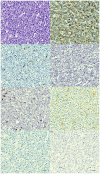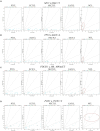Single nucleotide polymorphism profiles of canine T-cell and null-cell lymphomas
- PMID: 39176397
- PMCID: PMC11339873
- DOI: 10.3389/fvets.2024.1439706
Single nucleotide polymorphism profiles of canine T-cell and null-cell lymphomas
Abstract
Background: The histopathological classification of T-cell lymphoma (TCL) in humans has distinctive mutational genotyping that suggests different lymphomagenesis. A similar concept is assumed to be observed in dogs with different TCL phenotypes.
Objective: This study aimed to identify the previously reported single-nucleotide polymorphisms (SNPs) in both human beings and dogs in canine TCLs and null-cell lymphomas (NCLs) and to design compatible oligonucleotides from each variant based on the multiplex polymerase chain reaction.
Methods: Genomic DNA was extracted from 68 tumor specimens (62 TCLs and 6 NCLs) and 5 buffy coat samples from dogs with TCL. Four TCL subtypes and NCL were analyzed in 44 SNPs from 21 genes using the MassARRAY.
Results: The greatest incidences of SNPs observed in all TCL subtypes and NCL ware SATB1 c.1259A > C, KIT c.1275A > G, SEL1L c.2040 + 200C > G, and TP53 c.1024C > T, respectively. Some SNP locations were statistically significant associated with NCL, including MYC p.S75F (p = 0.0003), TP53 p.I149N (p = 0.030), PDCD1 p.F37LX (p = 0.012), and POT1 p.R583* (p = 0.012).
Conclusion: Each TCL histological subtype and NCL are likely to contain distinctive mutational genetic profiles, which might play a role in lymphoma gene-risk factors and might be useful for selecting therapeutic target drugs for each canine patient.
Keywords: SNPs; cutaneous T-cell lymphoma; dog; intestinal T-cell lymphoma; nodal T-cell lymphoma; null-cell lymphoma.
Copyright © 2024 Sirivisoot, Kasantikul, Techangamsuwan and Rungsipipat.
Conflict of interest statement
The authors declare that the research was conducted in the absence of any commercial or financial relationships that could be construed as a potential conflict of interest.
Figures





References
-
- Valli VE, Bienzle D, Meuten DJ. Tumors of the hemolymphatic system In: Meuten DJ, editor. Tumors in domestic animals. Ames, IA, USA: John Wiley & Sons, Inc. (2016). 203–321.
LinkOut - more resources
Full Text Sources
Research Materials
Miscellaneous

